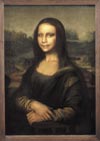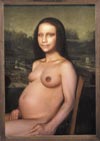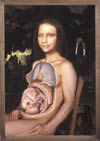Art Department
Back to Contents of Issue: June 2000
|
|
||||
|
by Andrew Pothecary |
||||
It happens occasionally in every big gallery in every big city, and Tokyo is no exception: an over-priced, over-attended, themed exhibition. In this case, earlier this year the Tokyo Metropolitan Art Museum held the "One Hundred Smiles of Mona Lisa" -- a collection of works inspired by the icon from which only the original remained absent. On the top floor, smiling like a wallflower, and almost as unnoticeable, was Yasumasa Morimura's own version from his "Self-Portrait as Art History" series. Only his fully clothed version -- as coy as the real thing -- was on display, but actually there's a tryptich, as pictured here. Playing with tradition is (obviously) not a new idea. From Duchamps' famous moustache addition (the Mona Lisa again) to, more recently, American photographer Andres Serrano's use of Photoshop to make black Rembrandts. Morimura, however, plays not only with the Mona Lisa, but with iconography, fame, and the history of art. He merges himself with a host of imagery via a variety of techniques, from simply dressing up to computer merging with the Mona Lisa. His Marilyn Monroe for example, ends up cartoonishly male (or campishly female). Nothing is sacred in Morimura's attack on fame, and that's most of the point. His question may be why are these images -- from the 17th-century Dutch paintings to contemporary Cindy Sherman photos -- deemed important or sacred? That he's becoming an icon himself is part of the play. Indeed, if you must throw around phrases like "post-modern irony" then here's your chance. Especially when you add in the fact that Sherman, an American photographer who often also appears in her own pictures (from historical art -- again -- to a set of imaginary film stills) is already playing with iconography: Morimura as Sherman as an imaginary film still. Confused? C'est la vie. Technology makes no image sacred. Morimura may be initially playing with Western assumptions of artistic importance, but he's also sometimes using technology that is further enabling the questioning of veracity. (It's perhaps especially apparent in Japan -- which can sometimes hungrily absorb icons and challenge copyright and auteurship.) Of course, it has always been so -- was the Turin shroud a Leonardo photo, were students applying all the paint to masterpieces? -- but technology makes it fast, loose, immediate, and sometimes untraceable. It also gives a helping hand to artistic ideas like Morimura's.
|
||||
Note: The function "email this page" is currently not supported for this page.








